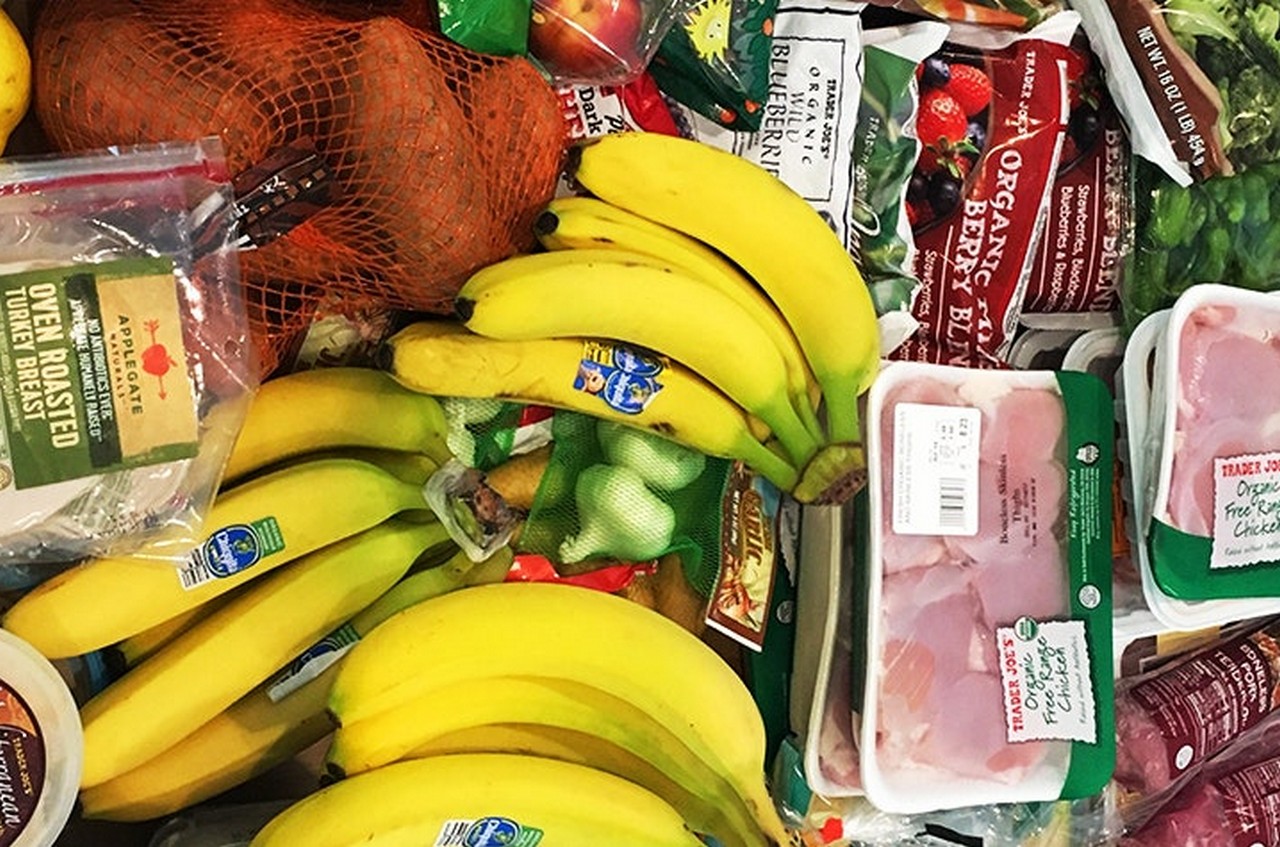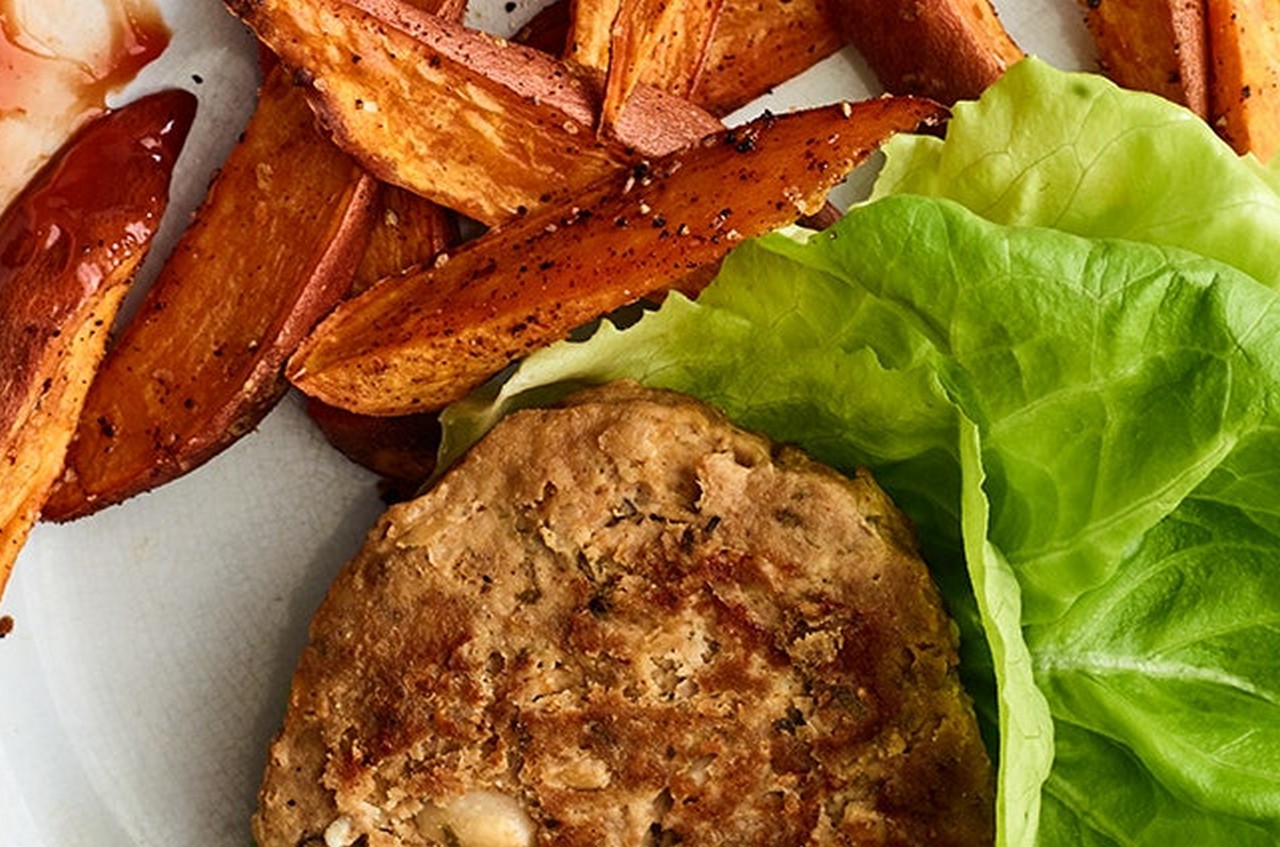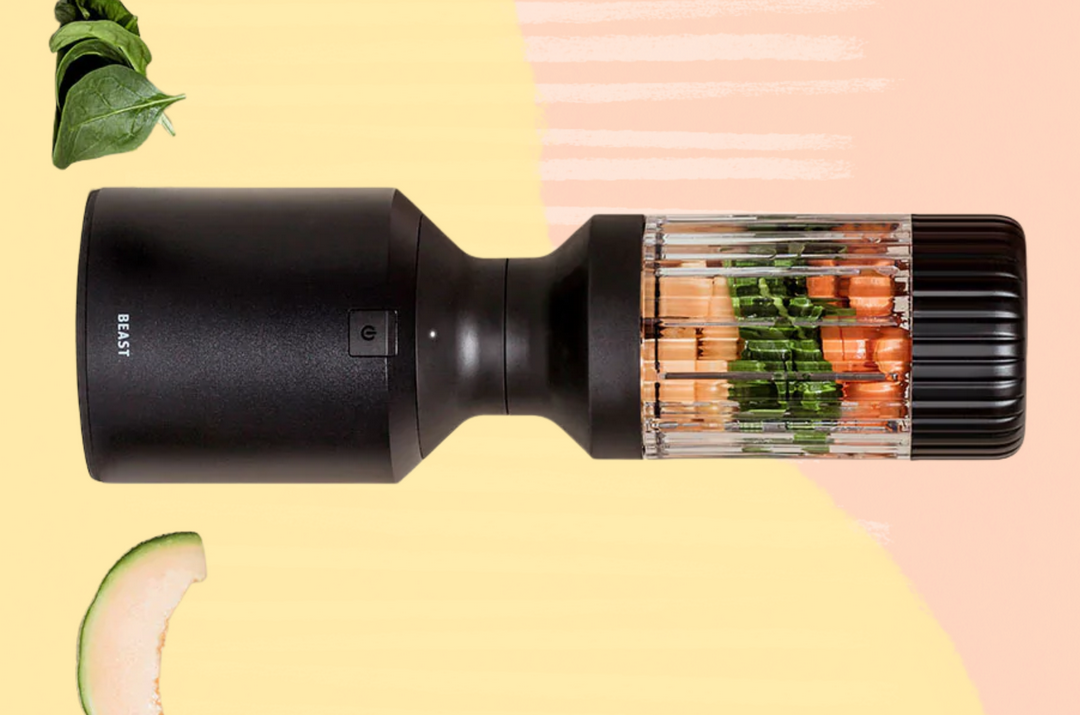
I love grocery shopping. When it comes to self-care or me-time, I’d take wandering around a grocery store over a bubble bath any day. For years, I made weekly grocery shopping a priority. It was practical—I’d stock our kitchen for the week ahead—and it provided much-needed respite. As a stay-at-home/work-from-home mom with a baby and a toddler, alone time was a pretty elusive thing. So every Saturday morning I’d grab my reusable bags and leave our house by 7:40 A.M. I’d roll up to our nearest Trader Joe’s (which is actually 20 minutes away) just as the doors opened, coffee in one hand and shopping list in the other.
I’d scour the store for our goods. I was on a mission to cross everything off of my list, but I’d also give myself the occasional moment to pause and inspect a new product or taste the sample of the day. I’d return home around 10 A.M., unpack and put away our groceries, and rejoin my family. I was so committed to this routine that I even did it the day I went into labor with our youngest son #truestory.
But a few months ago, something shifted. I stopped looking forward to my weekly shopping excursion and started feeling like I was missing out on quality time with my family. My husband works long hours during the week, so the only time we get to be together as a family is on the weekends. I envisioned sipping coffee with him and playing with our kids on the floor instead of sprinting out the door to take care of the weekly shopping haul.
When weekend grocery shopping started feeling like another chore, I experimented with some possible solutions. I tried grocery shopping on a weekday with both kids in tow, but that was more stressful than going alone. For a few weeks, I had our groceries delivered. It was convenient, but I inevitably forgot to add a few things to my cart and still ended up hitting the store. My husband chips in with plenty of things around the house, but he’s on kid-watching duty while I’m at the grocery store. (Like many couples, we divide chores fairly and equally based on what we’re good at and enjoy: I love cooking and meal prep, so it’s one of the things I take care of. He takes care of numerous other household tasks.)
One night it dawned on me: What if, instead of shopping weekly, I could find a way to go once per month?
Even if I did it on a weekend morning so my husband could stay with the kids, it would only be one Saturday morning per month, instead of every single week. I’d get the me-time grocery shopping fix that I still craved—and the other weeks, I’d be able to spend quality time with the whole family together. It was 11 p.m. (like most good ideas, this one came to me in the shower), but I was so amped on this idea that I couldn’t shut my eyes. I spent hours researching how other people were doing it, and discovered that shopping once a month is totally a thing.
My greatest reservation was whether we could continue eating healthy, home-cooked meals with plenty of fresh ingredients all month long. If we’d have to spend the last week of every month dining on frozen pizzas and pot stickers, that would be a deal breaker for me.
Despite my hesitations, I decided to give it a shot. I knew I might not get it down right away, but I read up and gathered as much advice as I could. If I was going to do this, I was going to do it right—and for me, that meant without sacrificing the health, freshness, and quality of my family meals.
Since then, I’ve been grocery shopping for our family once a month and it’s been nothing short of life changing.
Only going to the grocery store once a month means that I come home with a much bigger haul, but it’s proved totally worth it.
It’s been four months. The first Saturday of every month I go to Trader Joe’s or Costco (sometimes both, if I can swing it) and stock up on what we need for the next four weeks. We joined a CSA, which delivers fresh fruits and vegetables weekly. We also stroll the farmers market each week as a family, which assuaged my doubts about being able to keep fresh food in the house.
I’m certain there’s nothing magical about what I’m doing. With trial and error, I’ve learned and continue to learn tricks that make it possible. It’s a constantly evolving process, but here are some strategies that help make a monthly shop work:
1. I keep a grocery list going all month long.
As we run out of foods or I think of an item I’d like to have in the house I add it to my growing list. If I think of a meal I’d like to make the following month, I put the ingredients on my list. At the end of the month I add anything else we need. To make my big shop easier, I then create a new, cleaner list where I divide the items into different sections of the store: Produce (fruits and vegetables), dairy/refrigerated items (milk, cheese, yogurt, kefir, butter, hummus, etc.), meats (chicken thighs, ground beef, etc.), frozen items (frozen fruit and vegetables, wild salmon, shrimp, waffles, etc.), and dry goods (oats, peanut butter, bread, quinoa, tomato sauce, beans, etc.) and cross them off as I shop.
2. I figure out exactly how much food we need.
I dove into monthly shopping without knowing exactly how much of certain foods—especially staples like eggs, milk, bread, and yogurt—we go through. I quickly realized I had no idea how much we consume in a month. I bought one gallon of milk and discovered that we needed three. I bought two-dozen eggs and found that we needed four. I’ve got it down now, but if I were to start over again, I’d take a month to record exactly how much of everything we typically eat before attempting a monthly shop.
Most Popular
- 5 Less Obvious Signs of Seasonal Depression You Should Definitely Pay Attention To
By Maggie O’Neill
- 42 Creative Valentine’s Day Gifts for Guys
By Sarah Madaus
- Just Some Fun Sex Toys You and Your Partner Will Love
By Gabrielle Kassel
It took me a few months to figure out just how much food we go through every month (it’s a lot!), but this is what my monthly haul looks like these days.
3. I buy versatile ingredients and plan meals based on what we have on hand.
When I used to shop each week, I’d make a meal plan for the week ahead and buy the ingredients I needed. When I researched how other people shop once a month, I learned that they either meal plan for an entire month ahead of time, or they buy lots of ingredients and plan meals based on what they have. I was sure I’d fall into the first camp, but when I tried to plan an entire month of meals, I felt overwhelmed. Instead, I buy ingredients I know the whole family will eat, in bulk, and then come up with a plan at the beginning of each week using what we have.
Most Popular
- 5 Less Obvious Signs of Seasonal Depression You Should Definitely Pay Attention To
By Maggie O’Neill
- 42 Creative Valentine’s Day Gifts for Guys
By Sarah Madaus
- Just Some Fun Sex Toys You and Your Partner Will Love
By Gabrielle Kassel
I have a deep freezer that I stock with meat, veggies, and other ingredients.
4. I freeze almost all of the meat right away, then thaw it out as needed.
As soon as I get home from the store, the majority of our meat goes into our freezer. We have a deep freezer in our basement, which affords us the extra space to store our food. Every few days, I move what we need from the freezer to the fridge so it’s thawed by the time I need it for a meal. If you don’t have the extra space, it may be a good idea to clean out your freezer before you head to the store.
5. I make the most out of frozen produce.
Although we get fresh fruits and veggies from the farmers market and CSA (more on that below), I also keep the frozen stuff on hand. I learned that you can totally roast most veggies from frozen just like you would fresh produce. I’ve roasted broccoli, cauliflower, Brussels sprouts, and more by dumping the contents of a freezer bag onto a baking sheet, tossing with some olive oil, and sticking it in a 425-degree oven for about 30 minutes. I also use the freezer to make produce last—I buy a big container of baby spinach at Costco, but when it starts to wilt, I transfer the rest of the spinach to the freezer and blend it into our daily smoothies.
My weekly CSA haul is insurance that we always have plenty of fruits and veggies in the house.
6. We take a family outing to the farmers market each week. I also signed up for a CSA.
We pick up our fruit and veggie CSA* once a week throughout the summer and shop the weekly farmers market when it’s open (Memorial Day through Thanksgiving). I set a budget for $15 each week at the farmers market and buy a few fresh items that I know we’ll get through that week, such as lettuces for salads and sandwiches, cucumbers (my toddler loves them), summer squash, and apples when they’re in season.
Most Popular
- 5 Less Obvious Signs of Seasonal Depression You Should Definitely Pay Attention To
By Maggie O’Neill
- 42 Creative Valentine’s Day Gifts for Guys
By Sarah Madaus
- Just Some Fun Sex Toys You and Your Partner Will Love
By Gabrielle Kassel
While this technically means I’m food shopping more than once a month, these weekly farmers market trips are more of a group activity than a chore. I love exposing our kids from an early age to all of the sights, smells, and tastes around us (even if our toddler’s favorite farmers market food is a pickle on a stick) and we enjoy spending the time together outdoors, running into neighbors and friends, and feeling more connected to our community.
*(Editor’s note: CSA stands for Community Supported Agriculture, and it’s an easy way to buy fresh produce directly from a local farmer. Typically, you’ll sign up for a CSA at the beginning of the season, pay in advance for weekly or monthly boxes of produce, then pick up your box at a designated time and location every week or month. What’s in your box will vary by season, depending on what’s available and plentiful. To learn more or find a CSA near you, check out Local Harvest.)
7. I’ve accepted that there will be repetition.
We don’t eat the same thing every single week, but certain ingredients make an appearance more often than they used to by virtue of the fact that I’m now buying in bulk.
8. When I run out of something, I get creative with the ingredients I have.
If I run out of something, I try to make do without it until the following month. One month I ran out of chili powder and cumin, yet I still made tacos twice. Did you know that adding salsa to ground turkey or beef while cooking gives it tons of flavor even when you’re lacking key spices?
My meal prep includes chopping fruits and veggies, hard-boiling eggs, baking muffins for breakfast, and sometimes cooking a meal that reheats easily.
9. I meal prep, meal prep, and do more meal prep.
Seriously, it’s everything. At the beginning of the month, our refrigerator looks pretty intimidating packed with a month’s worth of food. Meal prep saves me. Every weekend while the kiddos nap, I slice fruits and veggies we’ll eat over the next few days, bake muffins for breakfasts and snacks, hard-boil eggs, cook some type of grains that we’ll use for dinners, and do whatever I can to make it easier to get through our groceries so that nothing gets lost in the fridge or goes to waste. (For my favorite meal-prep inspo, check out @theleangreenbean and @shutterbean on Instagram.)
One unexpected, but much appreciated, benefit of my monthly grocery shop is that we’re saving about $100 per month.
During this time in our lives when we’re very aware of where every dollar goes, saving money has been a huge bonus for our family. Simply reducing the number of times I’m in a store means there are fewer opportunities for impulse purchases, buying something just because it’s on sale, or grabbing an item we might run out of in the next seven days and believed we couldn’t survive without.
I’m also saving time.
I can do a monthly grocery shop in approximately the same amount of time as I used to do a weekly one. There’s also the time that I save making my list, driving to and from the store, loading the groceries into my car, unloading them into our house, unpacking, and putting them away. Now I do those tasks once a month instead of once a week. Meal prep takes about the same amount of time: Whether I shop once a week or once a month, I’ve always meal prepped. It makes meals and snacks come together in a fraction of the time during the week, which is essential when I’m on my own with the kids during the week. I can accomplish a huge amount of meal prep in 60 minutes or less.
I’m literally saving hours each month—hours that I get to spend with my family, drinking coffee with my husband, playing with our kids on the floor, strolling through our neighborhood, and meeting up with friends and their kids at the farmers market.
What I never imagined was how much personal fulfillment this little experiment would bring. I identified a system that wasn’t working, came up with a plan, and put in the effort to change and make it work for us. I found a way to still get the job done without compromising on my own happiness. Finally, I realize that this is an ongoing process that I’ll continue to refine as time goes on so I try to be gentle with myself about the whole thing. If we occasionally run out of something that we really, really can’t do without, then I load the kids into the minivan, drive to our local market, and get it. Thankfully, the store sells wine, too.














